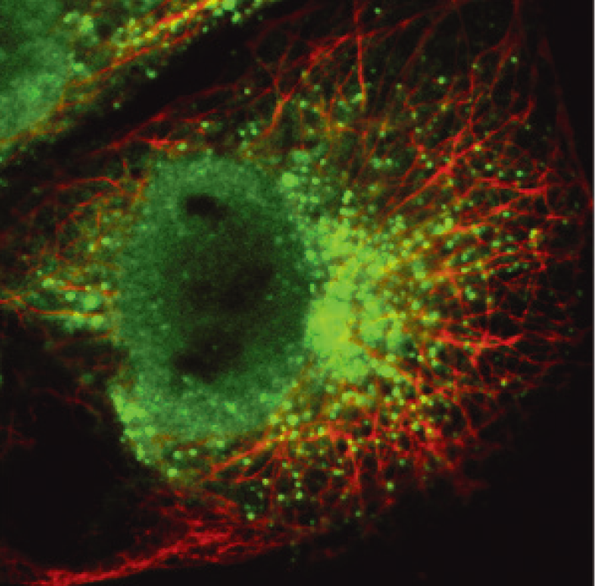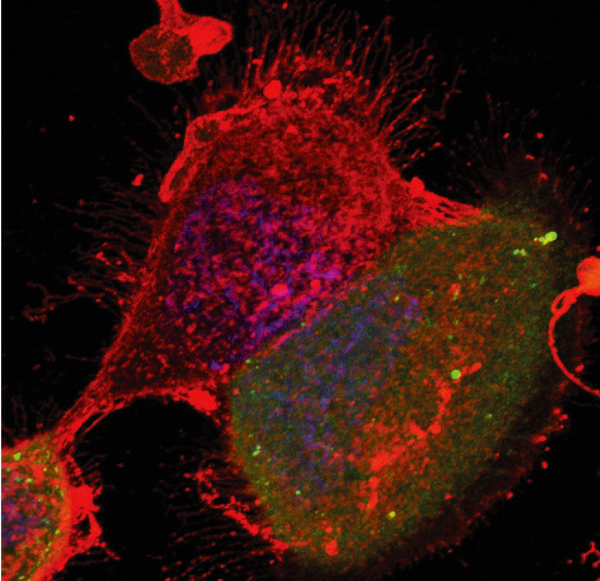キーワード: 細菌、ウイルス、寄生虫、生体防御、医薬品開発
http://www.md.tsukuba.ac.jp/basic-med/infectionbiology/microbiology/index.html
http://www.md.tsukuba.ac.jp/basic-med/infectionbiology/virology/index.html
 人類は長い歴史を通じてずっと感染症と闘ってきました。しかし、現在でも世界の死亡原因のおよそ15%は感染症が占めています。微生物やウイルスがどのように感染症を引き起こすのかについては、実は未解明の点が多く残されています。リサーチユニット「感染生物学」は、感染という現象の理解を深め、感染症を制御することを目指す研究者のグループです。
人類は長い歴史を通じてずっと感染症と闘ってきました。しかし、現在でも世界の死亡原因のおよそ15%は感染症が占めています。微生物やウイルスがどのように感染症を引き起こすのかについては、実は未解明の点が多く残されています。リサーチユニット「感染生物学」は、感染という現象の理解を深め、感染症を制御することを目指す研究者のグループです。
感染体と宿主の相互作用を理解する
感染症は、微生物やウイルスがヒトの体内に侵入することによって引き起こされます。そこには侵入する側(感染体)と侵入される側(宿主)が存在するわけですが、これまでの研究は感染体について理解しようとするものに偏っていました。一方で私たちは、感染という現象を理解するためには感染体と宿主の相互作用を分子レベルで明らかにすることが重要であるという考えのもと、感染体と宿主の研究に取り組んできました。以下に、私たちが取り組んでいる研究テーマか
ら3つを取上げてご紹介しましょう。
感染症は古くて新しい研究領域

図1:細胞核で複製したウイルスゲノムが微小管により輸
送されている様子
赤:微小管、 緑:ウイルスゲノム
皆さんご存知のとおり、インフルエンザは毎年世界中で猛威をふるいます。しかし、その原因であるインフルエンザウイルスについては、宿主細胞の核でどうやってウイルスゲノムを増幅し、細胞外に運び出されるのかさえ分かっていませんでした。私たちは、ウイルスゲノムの複製に必要な宿主のタンパク質を複数同定し、その輸送には微小管という細胞の骨格が必要であることを明らかにしました(図1・2)。
黄色ブドウ球菌は、2割程度のヒトの鼻腔に常在しており、病原性遺伝子や薬剤耐性遺伝子を外部から取り込んで多剤耐性株へと進化する病原細菌です。私たちは、黄色ブドウ球菌がどのようにヒトの体内環境に適応しているのか、どうやって病原性遺伝子や薬剤耐性遺伝子を外部から取り込むのか、という謎の解明に取り組んでいます。
トリパノソーマは、蚊など吸血性の虫を介してヒトに感染し、アフリカ睡眠病などを引き起こす寄生虫です。トリパノソーマのメッセンジャーRNAはヒトと異なり複数のメチル化修飾を受けます。私たちは、この寄生虫に特異的な修飾機構とその意義を明らかにすることで、新しい抗感染症薬の開発につなげることを目指しています。
このように、人類と感染症の闘いの歴史は長いにも関わらず、感染という現象の基礎的なメカニズムについては分かっていないことが数多くあります。生命現象の基礎的なメカニズムを明らかにすることは、大学というアカデミックな科学の担い手が取り組むべき課題です。私たちは、感染体の増殖の仕組みや宿主の防御機構を解明することが、将来的に感染症の新たな治療法開発に繋がっていくと考えています。

図2:ウイルス粒子が細胞から繊維状に出芽している様子
赤と緑:ウイルス感染細胞 青:細胞核
社会への貢献・実績
- 感染における宿主応答の基本原理の解明
- 感染体増殖の分子機構の解明
- 感染症撲滅を目指した創薬研究
- 感染症研究における、広い視野を持つ人材の育成
取材:平成26年6月5日
Elucidate the phenomena of infection at the molecular level
Unit members : Ho, Kiong Nagata, Kyosuke Kato Kosuke Morikawa, Kazuya Ohniwa, Ryosuke Takeuchi, Kaoru 奥脇 暢 斎藤 慎二 村野 健作
Unit name: Infection Biology
Keywords: bacteria, virus, parasite, biological defense, drug development
 Humans have fought infection since ancient times. However, about 15% of people die of infections around the world. How bacteria and viruses cause infections remains unclear. Our research unit “Infection Biology” aims to facilitate understanding of the phenomena of infection for its control.
Humans have fought infection since ancient times. However, about 15% of people die of infections around the world. How bacteria and viruses cause infections remains unclear. Our research unit “Infection Biology” aims to facilitate understanding of the phenomena of infection for its control.
Understand the interaction between infectious agents and hosts
Infections are caused by bacteria and viruses that enter the human body. Although both infectious agents and hosts are indispensable for infections, the former has been more intensively investigated. On the other hand, we have investigated both subjects, because elucidating the interactions between them at a molecular level is critical for understanding the phenomena of infection. We will introduce three of our research themes.
Infection, an old and new research area.

Figure 1: Transport of the viral genome, replicated in the cell nucleus, by microtubules Red: microtubules, Green: viral genome
Influenza viruses spread every year all over the world. However, the mechanisms of how their viral genome replicate in the nuclei and transport out of the cells remain unclear. We have identified several host proteins required for viral genome replication and demonstrated that cytoskeletons called microtubules were critical for their transport (Figures 1 and 2).
Staphylococcus aureus infects nasal cavities, with a prevalence rate of about 20%. It is pathogenic bacteria, which evolve into a multi-drug resistant strain by incorporating virulence and drug resistance genes from the outside. We are investigating how Staphylococcus aureus adapts itself to the environment of the human body or incorporates virulence and drug resistance genes from the outside.
Trypanosome is a parasite that infects humans through blood-sucking insects, such as mosquitoes, and causes infectious diseases such as African sleeping sickness. Unlike the messenger RNAs of humans, those of trypanosome undergo multiple methylation modifications. We will reveal their specific modification mechanisms to develop anti-infective agents.
Thus, in spite of the long history of the battle against infection, the basic mechanisms of infection remain unclear. University researchers should elucidate the basic mechanisms of life phenomena. Elucidating the mechanisms of host defense and viral proliferation should lead to the development of novel therapies against infection.

Figure 2: Budding of fibrous viral particles from a cell Red and green: virus-infected cells, Blue: cell nucleus
Social contributions and achievements
- Elucidation of the basic principles of host response to infection
- Elucidation of the molecular mechanisms of viral proliferation
- Drug discovery to eradicate infectious diseases
- Development of human resources for infection research in various fields
Interviewed on June 5, 2014
